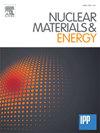First-principles study of beryllium thermodynamics and clustering mechanism in molybdenum: Effects of vacancies and self-interstitial atoms
IF 2.3
2区 物理与天体物理
Q1 NUCLEAR SCIENCE & TECHNOLOGY
引用次数: 0
Abstract
The clustering behavior of beryllium (Be) following plasma irradiation is of particular significance for molybdenum (Mo) in future fusion devices. Using first-principles calculations combined with thermodynamic models, the optimal configuration for Be clustering in Mo has been clearly determined, with a particular focus on the effects of vacancies and self-interstitials (SIAs). As the initial form of nucleation, the physical origin of Be-Be pair binding energy in Mo has been shown to be primarily dominated by the charge density at their location. Based on all of our computational results, a potential clustering mechanism for the formation of Be-rich regions in Mo is proposed: Be atoms first aggregate at interstitial sites, forming Ben clusters. When the number of Be atoms reaches six, they form an approximately “octahedral” structure, displacing a central Mo atom and generating a Be6V cluster and an SIA. They act as nucleation sites that continue to attract more Be atoms, growing into larger BenV and Ben-SIA clusters. As the Ben-SIA clusters expand, excess Be atoms displace more Mo atoms, creating additional SIAs and vacancies and further propagating the formation of Ben-SIA and BenV clusters. This cascading process ultimately results in the development of Be-rich regions within Mo. Our results provide significant data support for advancing Mo as a primary mirror material and also offer valuable theoretical insights into the aggregation behavior of impurities in metals under irradiation conditions.
铍在钼中的热力学和聚类机制的第一性原理研究:空位和自间隙原子的影响
铍(Be)在等离子体辐照后的聚类行为对未来聚变装置中的钼(Mo)具有重要意义。利用第一性原理计算结合热力学模型,明确确定了铍在钼中聚类的最佳构型,特别关注了空位和自间隙(SIAs)的影响。作为成核的初始形式,Mo中be - be对结合能的物理来源主要是由其位置的电荷密度决定的。基于我们所有的计算结果,我们提出了Mo中富Be区形成的潜在聚类机制:Be原子首先聚集在间隙位置,形成Ben簇。当Be原子数达到6个时,它们形成一个近似“八面体”结构,取代中心的Mo原子,产生Be6V簇和SIA。它们充当成核位置,继续吸引更多Be原子,成长为更大的BenV和Ben-SIA簇。随着Ben-SIA簇的膨胀,过量的Be原子取代了更多的Mo原子,产生了额外的SIAs和空位,并进一步传播了Ben-SIA和BenV簇的形成。这一级联过程最终导致Mo内部富be区域的发展。我们的研究结果为推进Mo作为主要镜像材料提供了重要的数据支持,也为辐照条件下金属中杂质的聚集行为提供了有价值的理论见解。
本文章由计算机程序翻译,如有差异,请以英文原文为准。
求助全文
约1分钟内获得全文
求助全文
来源期刊

Nuclear Materials and Energy
Materials Science-Materials Science (miscellaneous)
CiteScore
3.70
自引率
15.40%
发文量
175
审稿时长
20 weeks
期刊介绍:
The open-access journal Nuclear Materials and Energy is devoted to the growing field of research for material application in the production of nuclear energy. Nuclear Materials and Energy publishes original research articles of up to 6 pages in length.
 求助内容:
求助内容: 应助结果提醒方式:
应助结果提醒方式:


